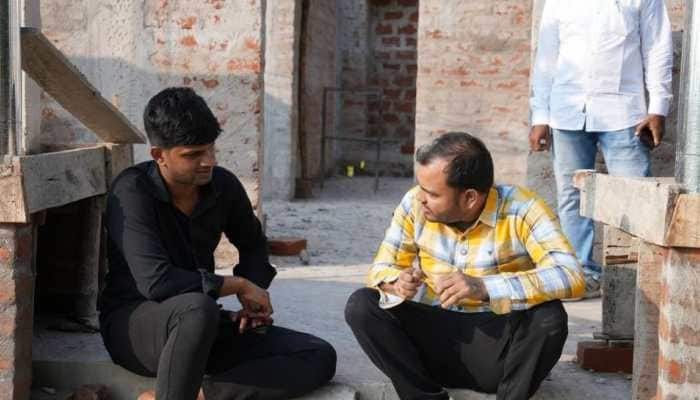Beyond air pollution, is there more to stubble burning than meets the eye?
Those looking to destabilise India keep coming up with new ways to derail the country.
Trending Photos
)
Diwali was celebrated this year. Surely with a Supreme Court's order for bursting of crackers between 8-10 PM. Indeed agitated and concerned was Honorable Supreme Court with the growing levels of pollution in the country overall and particularly in Delhi. It is a matter of concern which is not just agitating everyone but also affecting everyone's health. Especially the children growing up in Delhi are most vulnerable. I do not want to pass on any comment on Supreme Court's order. They adjudicated on whatever was the issue arraigned before them. We should respect the order.
Delhi of an earlier era
Let me share with the readers that I am a Delhite to the core I was born in Connaught Place, and have grown up and lived in South Delhi most part of my life except for brief interludes of living in the UK and Mumbai. The Delhi I grew up was the Delhi of 1970s and 1980s and the air was much purer in Delhi those days.
Pollution was not known to us as children except a pun here or a jest there when someone farted. That was the only pollution we knew as children and youth. It was also related to life styles. Notwithstanding all the negative connotation of DTU (Don't Trust Us) or DTC (Disgraceful Transport Confusion), people overall were using these public transport as a primary mode of intra-city commute. Scooters were a rarity and cars were deemed elitist.
Increasing pollution in Delhi
However, the growth of the vehicle population has indeed grown by leaps and bounds in the last two decades which as a consequence has given rise to increasing pollution in our Delhi. A young scientist, Ms. Anumita Roychowdhury, of the Centre for Science and Environment has done real time and highly creditable work on this with attendant crisis like shrinking public spaces due to parking, impact on public health etc. She really deserves kudos for this and her work has created awareness in the government circles to address the concerns. Both the Government of Delhi and the Government of India have been flagged because of this work and have calibrated several measures in combating this. But the sheer numbers are a matter of concern, which is becoming insurmountable for any counter measures to really have an impact.
Venom multiplier
Leaving the vehicular pollution behind, we are also concerned with pollution on account of several other factors like industrial pollution and illegal factories and dyeing units operating from households, on which the judiciary has indeed given appropriate directions from time to time. But one factor which generally leads to pollution during Diwali time is the stubble burning in the states of Punjab and Haryana. This results in air quality being rendered extremely poor. This in turn leads to a situation of Diwali crackers being a venom multiplier. It is this which I seek to examine and put in perspective.
Was there stubble burning hitherto?
As already recalled, I have been living in Delhi for one year short of six decades. This has endowed me with opportunity to travel into nearby and neighbouring states like UP, Punjab, Haryana and Rajasthan on quite a few occasions in different stages of life. I can say for sure that hitherto this trend of stubble burning was never in vogue. It was not even a known phenomenon. May also say for sure that during my travel in the hinterland areas neighbouring Delhi, it was not just sightseeing but I also had this opportunity to interact with local rural populace, and I never once heard even a mention of stubble burning. Only recently has this practise begun amongst the farming community of northern India.
Agrarian practices in other regions
Let me also share with you experiences I have had with farmers of other regions of the country with whom I have had opportunity to interact during these years. As an officer of the Ministry of Textiles, I had the opportunity to speak to inhabitants of Naupatna in Odisha. The vocation of the people here are farming and handloom weaving to supplement their income. While partaking of their excellent food I had in January 2016 ascertained what crops they grow. They informed that while paddy is a primary crop, the second crop was pulses, vegetables, etc.
Again in April 2016, I had this opportunity to travel to hinterland of West Bengal from a handloom cluster in Fulia and Shantipur to Murshidabad handloom cluster. Handloom weaving is closely intertwined with the agrarian economy and here too the interaction with local inhabitants revealed that they generally grow paddy as the primary crop with a large platter of very exotic rural vegetables (contrary to myth, Bengalis consume many varieties of vegetables which are known only in the Southern and Eastern parts of the country).
Further recently, I travelled to Tamil Nadu, where again my journey took me from Madurai to Dindigul, Natham, Sivagangai, Pillaiyarpatti, Rameswaram, Tirunelveli, Sankarankoil, Srivilliputhur, Satthur, and back to Madurai. I interacted intensively with local inhabitants. Being able to speak Tamil, I was at a distinct advantage of striking a chord with them. I was told by the farming community that they have two crops namely paddy being the primary one while the other being bananas, coconuts, palm, mangoes, etc.
Now, in all these interactions I sought to know what they do after harvest of the first crop before sowing the second. They all responded uniformly that they plough the land to make it ready for next crop. When asked about the residue of the previous crop again there was common response that the residue acts as a nutrient ('satthu' as told in Tamil to be me by a farmer).
Let me make one thing clear, that this is based on my interaction with farmers and not any laboratory findings of any scientific data. But one thing was clear, no one said that they burn the stubble. I was little surprised. It may surprise many that two decades back no one had heard of any phenomenon called stubble burning even in the North Indian states of Punjab and Haryana. An Agricultural Extension Officer would be able to confirm this. Stubble burning was known in certain pockets resorting to jhum cultivation, but that was a phenomenon in certain pockets and scientists were working for this practise to end.
When did it start in food bowl of India?
The next question is when and where did this stubble burning begin? Who introduced this phenomenon? Was it a endeavour to alter the agrarian practises? Was there a hidden agenda to make gullible farmers contribute to the destabilisation of the economy of the country?
Make no mistake, this phenomenon has been introduced in two states which were the food bowl of the nation. One of them is a border area which had seen militancy affecting its agrarian economy for two decades not very far back. There are many for whom the wounds of militancy are still to heal.
Is it an attempt at destabilisation?
Also, recent attacks on Nirankari Bhavan in Rajsansi near Amritstar does reveal the unholy involvement of ISI through al Qaeda in these attacks. Not just that Gurdaspur (Pathankot), drug menace and such other dysfunctional events in recent past do have the ISI's stamp. Is the ISI, which is latently active through its sleeper cells in Punjab, also seeking to alter agrarian practises to discredit the farmers of Punjab in nation's eyes and foist disaffection in the state?
Indeed, their previous endeavour of destabilising the Indian economy through Fake Indian Currency Notes (FICNs) got a setback due to demonetisation. Is the ISI peddling an alternative endeavour? One possible method which could prove as litmus test for this could be to check whether the farming community in Pakistan on other side of Punjab indulges in stubble burning after harvest of a crop. We need to find the truth and combat the same.
(Disclaimer: The opinions expressed above are the personal views of the author and do not reflect the views of ZMCL.)
Stay informed on all the latest news, real-time breaking news updates, and follow all the important headlines in india news and world News on Zee News.
Live Tv







)
)
)
)
)
)
)
)
)
)
